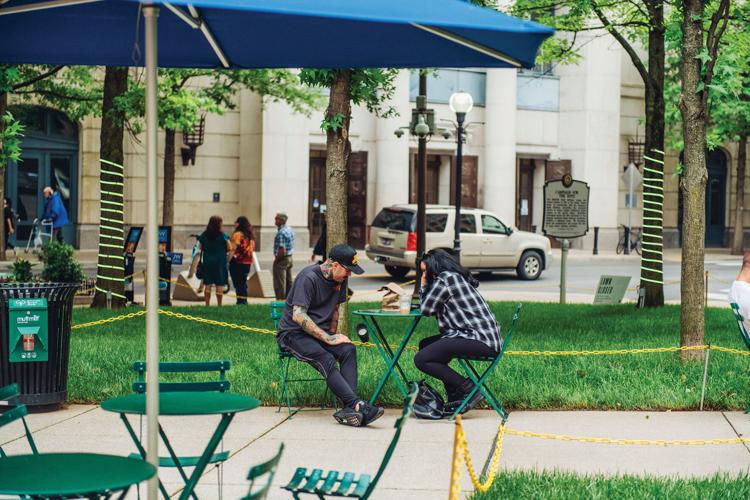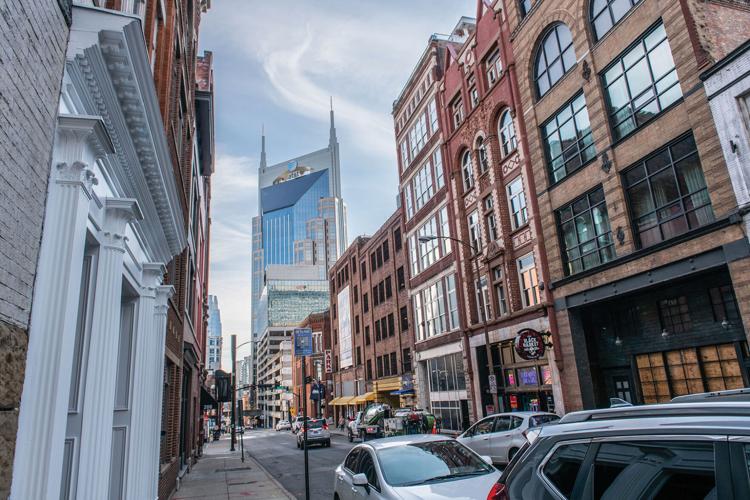
Church Street Park downtown
Street View is a monthly column taking a close look at development-related issues affecting different neighborhoods throughout the city.
Downtown Nashville can often feel like a tourist playground full of expensive parking, loud nightlife and party buses. But the new Downtown Code Design Guidelines envision a different downtown: one that’s walkable, with connected streets, greenery, accessible public spaces and flood protections, and one that encourages growth in line with existing architectural character.
The new draft of the Metro Nashville Planning Department’s Downtown Code Design Guidelines serves as a roadmap for developers to propose projects that align with the future that downtown city leaders want to see. The guidelines are split into four major areas: sustainability and biodiversity; accessible and inclusive spaces; multimodal transportation; and cohesive design.
With sizable mixed-use developments popping up regularly across the city alongside plenty of change at downtown’s doorstep on the East Bank, the design guidelines could have a big impact on the future of the city center.
Richel Albright, communications director for the Planning Department, says the city wanted a way to give developers consistent feedback about its priorities and encourage developers and city officials to think about what downtown could feel like. “We want to make sure we encourage great design that would entice people to want to live in the downtown area, and not just see it as a place to play,” Albright says.

While the guidelines are just that — they can’t enforce any standard in the way a zoning code or other regulatory tools can do — Albright says developers have generally been on board with the planning department’s feedback and want to build good projects. Social pressure also plays a role: Developers don’t want to create projects the city doesn’t like.
The “Future-Focused Ecological Design” section of the draft guidelines makes recommendations to tackle issues like heat islands and flooding. It also prioritizes creating more green spaces downtown, including “pocket parks” and integrated native greenery within developments. The ecological guidelines also highlight stormwater management solutions like drainage layers on roofs and landscape irrigation. They suggest planting trees to reduce heat islands and prioritizing mature trees when possible. To tackle Nashville’s building waste problem, the guidelines recommend sustainable design choices like using renewable or recycled materials when possible. They also mention prioritizing parking spaces for electric vehicles and people who carpool, and designing roofs and walls to generate renewable energy.
Councilmember Jacob Kupin represents District 19, which encompasses Nashville’s downtown core. He says he’s excited about the placemaking potential in the design guidelines, which can shape how people experience downtown. There’s a particular emphasis on placemaking in the “Human-Oriented Design” and “High-Caliber Architectural Design” sections.
“We’re really starting to look for pretty exciting, unique buildings that add to the skyline and take into consideration the other buildings that are going up around them,” Kupin says.
Another part of placemaking is transit, with recommendations that developments should connect to public transportation and make space for multimodality. The Downtown Code Design Guidelines include a specific focus on bicycle-friendly infrastructure like safe parking, and additional suggestions for streetscapes that are easy for pedestrians. Kupin tells the Scene the next draft of the guidelines will have even more bike infrastructure.
The “Human-Oriented Design” section touches on accessibility, with recommendations for integrating accessible wayfinding information, adhering to Americans with Disabilities Act guidelines and creating open and easily accessed public spaces.
But despite accessibility efforts, there are aspects of downtown life that design recommendations can’t control. While the design guidelines tell developers to “engage the community to identify and address their needs … within a project proposal that serves the greater community” (page 24), downtown Nashville has work to do if it wants to continue to support a diverse arts scene. As Tennessean columnist Andrea Williams recently wrote, the 2020 Christmas Day bombing destroyed BB Kings, a significant spot for Black artists to perform in Nashville. “For all the talk about country music being mostly, artificially, white, the same can be said about the city’s live music scene,” Williams writes. “[Losing BB Kings] was devastating for Black musicians … BB’s was one of the only regular gigs *in town* for them.”
And while the development guidelines prioritize multimodality and welcoming spaces, they don’t address housing density or affordability, despite housing shortages and rising costs plaguing the city overall. Could downtown Nashville be a space for affordable units? What would incentivizing these units look like?

Ultimately, the changes downtown Nashville needs won’t all be solved by new design guidelines. It’s also up to those who live, work and visit downtown. Beyond advocating for designs that reflect Nashville’s diverse needs, people will also have to adapt to the changes a new downtown will bring, with its new modes of transportation and public green spaces.
“It may take a mindset shift,” says Albright, “for some people to think ‘Hey, I can sit on that grass during my lunch hour and eat my lunch away from my desk and read a book for 30 minutes.’ It’s about making spaces like that.”
“I think there’s a really big push right now to have downtown not just be Broadway or nothing,” Kupin says. “You’re seeing it really start to feel like neighborhoods.”
The Planning Department finished gathering public comments on the draft guidelines on May 8, and will release updated guidelines in the following weeks. The Design Review Committee plans to review and vote on the guidelines in early June.





